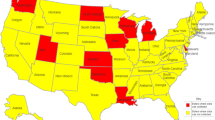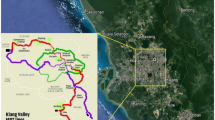Abstract
This article investigates the feasibility of multivariate adaptive regression spline (MARS) and least squares support vector machine (LSSVM) for the prediction of over consolidation ratio (OCR) of clay deposits based on Piezocone Penetration Tests (PCPT) data. MARS uses piece-wise linear segments to describe the non-linear relationships between input and output variables. LSSVM is firmly based on the theory of statistical learning, and uses regression technique. The input parameters of the models are corrected cone resistance (q t ), vertical total stress (σv), hydrostatic pore pressure (u 0), pore pressure at the cone tip (u 1), and the pore pressure just above the cone base (u 2). The developed LSSVM model gives error bar of predicted OCR. Equations have also been developed for prediction of OCR. The performance of MARS and LSSVM models has been compared with the traditional methods for OCR prediction. As the results reveal, the proposed MARS and LSSVM models are robust models for determination of OCR.







Similar content being viewed by others
References
Celik S, Tan O (2005) Determination of pre-consolidation pressure with artificial neural network. Civ Eng Environ Syst 22(4):217–231
Chan WT, Chow YK, Liu LF (1995) Neural network: an alternative to pile driving formulas. Comput Geotech 17:135–156
Chen BSY, Mayne PW (1994) Profiling the OCR of clays by piezocone tests, Rep. No. CEEGEO-94-1, Georgia Institute of Technology, Atlanta: pp 280
Das S, Samui P, Sabat AK, Sitharam TG (2010) Prediction of swelling pressure of soil using artificial intelligence techniques. Environ Earth Sci 61(2):393–403
Friedman JH (1991) Multivariate adaptive regression splines. Ann Stat 19:1–141
Goh ATC (1994) Nonlinear modelling in geotechnical engineering using neural networks. Aust Civ Eng Trans CE36(4):293–297
Goh ATC, Goh SH (2007) Support vector machines: their use in geotechnical engineering as illustrated using seismic liquefaction data. Comput Geotech 34(5):410–421
Hecht-Nielsen R (1990) Neurocomputing. Addison-Wesley, Reading
Kecman V (2001) Learning and soft computing: support vector machines, neural networks, and fuzzy logic models. The MIT press, Cambridge
Kumar B, Samui P (2008) Application of ANN for predicting pore water pressure response in a shake table test. Int J Geotech Eng 2(2):153–160
Kurup PU, Dudani NK (2002) Neural network for profiling stress history of clays from PCPT data. J Geotech Geoenviron Eng 128(7):569–579
Lee IM, Lee JH (1996) Prediction of pile bearing capacity using artificial neural networks. Comput Geotech 18(3):189–200
Mayne PW (1991) Determination of OCR in clays by PCPT using cavity expansion and critical state concepts. Soils Found 31(2):65–76
Nawari NO, Liang R, Nusairat J (1999) Artificial intelligence techniques for the design and analysis of deep foundations. Electronic J Geotech Eng. http://geotech.civeng.okstate.edu/ejge/ppr9909/index.html
Pal M (2006) Support vector machines-based modelling of seismic liquefaction potential. Int J Numer Anal Methods Geomech 30(10):983–996
Park D, Rilett LR (1999) Forecasting freeway link travel times with a multi-layer feed forward neural network. Comp Aided Civ Infra Struct Eng 14:358–367
Rahman MS, Wang J, Deng W, Carter JP (2001) A neural network model for the uplift capacity of suction cassions. Comput Geotech 28(4):269–287
Samui P (2008) Support vector machine applied to settlement of shallow foundations on cohesionless soils. Comput Geotech 35(3):419–427
Samui P, Kurup P, Sitharam TG (2008) OCR prediction using support vector machine based on piezocone data. J Geotech Geoenviron Eng 134(6):894–898
Smola A, Scholkopf B (1998) On a kernel based method for pattern recognition, regression, approximation and operator inversion. Algorithmica 22:211–231
Sully JP, Campanella RG, Robertson PK (1988) Overconsolidation ratio of clays from penetration pore pressures. J Geotech Eng 114(2):209–216
Suykens JAK, Vandewalle J (1999) Least squares support vector machine classifiers. Neural Process Lett 9(3):293–300
Suykens JAK, Lukas L, Van Dooren P, De Moor B, Vandewalle J (1999) Least squares support vector machine classifiers: a large scale algorithm. In: Proceedings of the European Conference on Circuit Theory and Design (ECCTD’99), Stresa, pp 839–842
Suykens JAK, De Brabanter J, Lukas L, Vandewalle J (2002) Weighted least squares support vector machines: robustness and sparse approximation. Neurocomputing 48(1–4):85–105
Systems Salford (2001) MARSTM User Guide. Salford Systems, San Diego
Tumay MT, Kurup PU, Voyiadjis GZ (1995) Profiling OCR and Ko from piezocone penetration tests. In: Proceedings of International Symposium on Cone Penetration Testing, vol 95, SGF Report No. 3, Swedish Geotechnical Society, Linkoping, pp 337–342
Vapnik VN (1998) Statistical learning theory. Wiley, New York
Author information
Authors and Affiliations
Corresponding author
Rights and permissions
About this article
Cite this article
Samui, P., Kurup, P. Multivariate adaptive regression spline (MARS) and least squares support vector machine (LSSVM) for OCR prediction. Soft Comput 16, 1347–1351 (2012). https://doi.org/10.1007/s00500-012-0815-7
Published:
Issue Date:
DOI: https://doi.org/10.1007/s00500-012-0815-7




